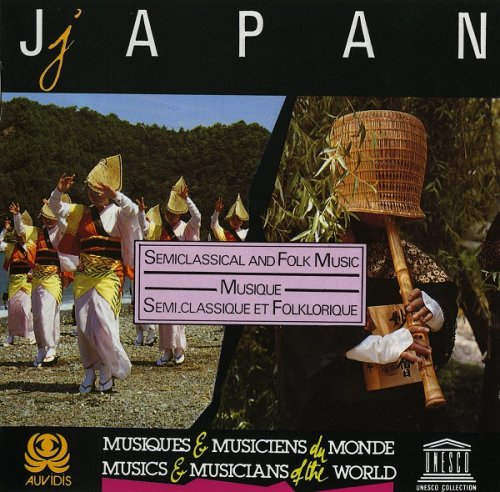
VA - Japan: Semiclassical And Folk Music - Musique Semi.classique et Folklorique (1989)
BAND/ARTIST: Various Artists
- Title: Japan: Semiclassical And Folk Music - Musique Semi.classique et Folklorique
- Year Of Release: 1989
- Label: Auvidis
- Genre: World, Folk, Ethnic
- Quality: FLAC (tracks+.cue, d.booklet)
- Total Time: 47:14
- Total Size: 276 Mb
- WebSite: Album Preview
Tracklist:
01. Toshimura Goroji - Kanjincho (Naga-uta shamisen music) (7:04)
02. Matsuo Keiko and Ueno Kazuko - Godan-kinuta (Koto duet) (6:02)
03. Notomi Judo and Notomi Haruhiko - Shika-no-tone (Shakuhachi Duet) (10:26)
04. Amada Kiichi and Hoshi Tenchin - Tsugaru yama-uta (Mountaineer's song) (2:53)
05. Irimura Yuki and Aoi-ren Group - Awa-odori (Bon dance) (3:26)
06. Akama Shinsui - TrackTairyo utaikomi (Fishermen's song)06 (4:57)
07. Yamairi Tsuru - Hatoma-bushi (Okinawa islands) (2:28)
08. Edobayashi Hozonkai - Edo matsuri bayashi (Festival ensemble of Tokyo) (9:59)
01. Toshimura Goroji - Kanjincho (Naga-uta shamisen music) (7:04)
02. Matsuo Keiko and Ueno Kazuko - Godan-kinuta (Koto duet) (6:02)
03. Notomi Judo and Notomi Haruhiko - Shika-no-tone (Shakuhachi Duet) (10:26)
04. Amada Kiichi and Hoshi Tenchin - Tsugaru yama-uta (Mountaineer's song) (2:53)
05. Irimura Yuki and Aoi-ren Group - Awa-odori (Bon dance) (3:26)
06. Akama Shinsui - TrackTairyo utaikomi (Fishermen's song)06 (4:57)
07. Yamairi Tsuru - Hatoma-bushi (Okinawa islands) (2:28)
08. Edobayashi Hozonkai - Edo matsuri bayashi (Festival ensemble of Tokyo) (9:59)
Japan's traditional music includes a rich variety of styles developed over more than a millennium. Among them are the ancient imperial court music (Gagaku), the musical drama form of the 14th century frequented by the feudal lords (Noh), and the "semi-classical music". Despite its name, this last category, created between the sixteenth and nineteenth centuries of various genres that are closer to what we could call "popular".
This 1974 recording contains three compositions of traditional Japanese semi-classical folk music and five of regional folk music, also from the late feudal period. Semi-classical representations include shamisen (lute), koto (zither) and shakuhachi (flute). The folk songs come from the mountains, the coast, Okinawa and Tokyo. The footnotes refer to contributions from other cultures (India, China, Korea, Indonesia) that have been equated with the very original Japanese civilization and also describe the traditions of performance.
This superb CD from the UNESCO collection produced by Auvidis gives an overview of the range of styles of traditional and folk music existing in Japan. The first piece is a song "naga-uta", accompanied by the shamisen, a three-stringed lute. "Naga-uta" is the singing style used in kabuki theater. The second piece is a well-known Japanese koto duet, the koto being a table zither. The third piece is probably the most famous piece of Japanese shakuhachi, "Shika-No-Tone", the shakuhachi being the well-known Japanese bamboo flute. Listeners hear his original duet version, although it can also be performed solo. As for folk songs, they are songs from different regions, such as Tsugaru, Okinawa and Tokyo, and for different occasions: a mountaineer song, a dance, a fisherman song, a festival song, etc.
This 1974 recording contains three compositions of traditional Japanese semi-classical folk music and five of regional folk music, also from the late feudal period. Semi-classical representations include shamisen (lute), koto (zither) and shakuhachi (flute). The folk songs come from the mountains, the coast, Okinawa and Tokyo. The footnotes refer to contributions from other cultures (India, China, Korea, Indonesia) that have been equated with the very original Japanese civilization and also describe the traditions of performance.
This superb CD from the UNESCO collection produced by Auvidis gives an overview of the range of styles of traditional and folk music existing in Japan. The first piece is a song "naga-uta", accompanied by the shamisen, a three-stringed lute. "Naga-uta" is the singing style used in kabuki theater. The second piece is a well-known Japanese koto duet, the koto being a table zither. The third piece is probably the most famous piece of Japanese shakuhachi, "Shika-No-Tone", the shakuhachi being the well-known Japanese bamboo flute. Listeners hear his original duet version, although it can also be performed solo. As for folk songs, they are songs from different regions, such as Tsugaru, Okinawa and Tokyo, and for different occasions: a mountaineer song, a dance, a fisherman song, a festival song, etc.
download flac
ISRACLOUD
ISRACLOUD
World | Japanese / 邦楽 | Folk | Ethnic | FLAC / APE | CD-Rip
As a ISRA.CLOUD's PREMIUM member you will have the following benefits:
- Unlimited high speed downloads
- Download directly without waiting time
- Unlimited parallel downloads
- Support for download accelerators
- No advertising
- Resume broken downloads


